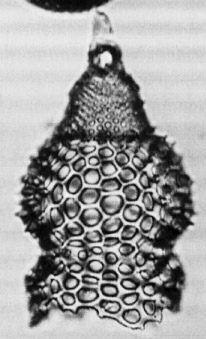 Theocorys
anaclasta Riedel and Sanfilippo
Theocorys
anaclasta Riedel and Sanfilippo Theocorys
anaclasta Riedel and Sanfilippo
Theocorys
anaclasta Riedel and SanfilippoTheocorys anaclasta Riedel and Sanfilippo, 1970, p.530, pl.10, figs.2-3; Riedel and Sanfilippo, 1978a, p.76, pl.1, figs.6-8
Cephalis spherical, poreless or with few small pores bearing a stout conical horn of variable length. Collar and lumbar strictures distinct. Thorax conical to hemispherical, with small subcircular pores. Abdomen broader than thorax, with thick wall (less robust in late specimens) and large rounded pores. Abdomen inflated in its main part, then constricting distally and expanded terminally, lacking distinct terminal ring. Proximal part of abdomen often thorny, and thorax less so (Riedel and Sanfilippo, 1970).
Based on 20 specimens. Length (excluding horn) 225-390 µm, maximum breadth 135-235 µm (Riedel and Sanfilippo, 1970).
Three-segmented form with stout conical horn and distinct collar and lumbar strictures. Abdomen inflated in its main part, then constricting distally and expanded to terminate in an undifferentiated margin.
The portion of the abdomen above its constriction is generally more voluminous than the thorax. Early specimens have abdominal pores, small and rather uniform in size; this serves to distinguish them from some late specimens of T. acroria Foreman with abdominal constriction (Foreman, 1973, p.439) (Riedel and Sanfilippo, 1978a).
T. anaclasta is distinguished from T. acroria Foreman (1973, p.439, pl.5, figs.11-13, pl.12, fig.2) by its more marked abdominal constriction (Sanfilippo et al., 1985).
Abdomen is inflated in its proximal part, then constricts distally and expands to terminate in an undifferentiated margin. The portion of the abdomen above its constriction is generally more voluminous than the thorax. Early forms have small abdominal pores, and late ones have large, irregularly rounded pores. Proximal part of abdomen is often thorny (Sanfilippo et al., 1985).
T. anaclasta is found in moderate abundance in tropical localities of early middle Eocene age. It does not occur at DSDP Site 248, south of Madagascar. Its morphotypic first appearance defines the base of the Phormocyrtis striata striata Zone. Its morphotypic last appearance lies within the Thyrsocyrtis triacantha Zone.
T. acroria, T. anapographa Riedel and Sanfilippo (1970, p.530, pl.10, fig.4) and T. anaclasta are apparently related to each other, but the details are not yet understood.